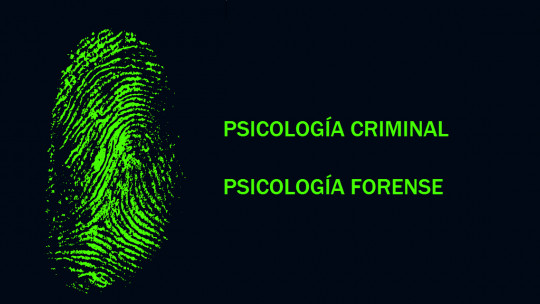In this era, it is not strange to often hear the term “dangerousness” in the news, radio and other media, especially when they talk about issues related to the criminal field.
“Highly dangerous criminal”, “medium dangerous prison” and other concepts and terms are examples of how we hear such terminology every day, to the point where we believe we are familiar with it. Despite this, this concept continues to be one of the most misunderstood within criminology since it is frequently confused with others such as aggressiveness and violence.
Furthermore, the new forms of crime that arise with new times force us to review and review it in depth. In this article We propose to conceptualize the concept of dangerousness, point out its characteristics and explain its importance
Criminal danger: knowing the history of the concept
The idea of danger is by no means new, however the concept of criminal dangerousness It is relatively modern.
Its clearest antecedent dates back to the theses of the German author Feuerbach, whose term would become part of the Bavarian Penal Code in 1800 and who defined it as the quality of a person that gives rise to a reasonable presumption that he or she will violate the right.
Modern definitions and approximations
The most modern definition of dangerousness was introduced to criminology by Rafael Garofalo with his fearfulness to designate the constant and active perversity of the offender and the amount of anticipated evil to be feared from the offender himself.
The concept, although controversial since then, was quickly accepted until 1892 when the International Union of Criminal Lawled by eminent masters of this branch of law such as Von Liszt and Prins, officially recognized it.
Unitary definition from criminology
Danger, from Latin periculum, refers to the risk, the imminent contingency of some evil happening being the situation, thing or obstacle that increases the possibility of some harm or damage.
Dangerousnesswhen we apply it to a person, it is the quality of damage that it could cause, taking into account the factors that impel it to do this damage The Royal Academy of Language accepts this term referring to a person as someone who can cause harm or commit criminal acts.
To make this concept clearer, let’s review other definitions given by various authors who study law and criminology. Rocco defines it as the power, attitude, suitability, and capacity of the person to be the cause of harmful or dangerous actions. Petrocelli defines it as a set of subjective and objective conditions under whose impulse an individual is likely to commit a socially dangerous or harmful act. The Quillet Encyclopedia says that dangerousness is the set of subjective conditions that authorize a prediction about an individual’s propensity to commit crimes.
As you can see, The common elements in the definitions are the potential and the intention to be prone to crime Just as there is a clear difference between aggression and violence, dangerousness is distinguished from the previous two in that both terms help us try to diagnose the latter.
Danger components
Scholars of criminal behavior agree that dangerousness has two essential components: criminal capacity and social adaptability
The first concept, the criminal capacity, refers to the internal criminal tension, the criminal power, what the criminal personality is capable of giving in the criminal field. For its part, the social adaptability It is the criminal’s suitability for social life, that is, the possibility of adapting the criminal’s activity to the environment in which it is inserted.
From these components we can recognize four forms of dangerous state
- Very strong criminal capacity and very high adaptability : The most serious manifestations of antisocial behavior are presented here, such as white-collar crimes, political-financial crimes, organized crime, organized psychopaths, etc.
- Very high criminal capacity and uncertain adaptability : less serious but with very harmful criminogenic potential. Their maladjustment makes them easily draw attention to themselves. Professional and specialized criminals, social outcasts, among others are in this category.
- Low criminal capacity and weak adaptation : They constitute the criminals who usually flood prisons. Among them are psychic maladjustments, character delinquents and similar typologies.
- Weak criminal capacity and high adaptability : light forms of crime. Its danger is low or acute (the danger can be chronic or acute depending on the duration; we will talk about this later). Occasional and passionate criminals are recognized here
Constituent elements of dangerousness
We will quote and explain below the most important characteristics of danger
Quantifying dangerousness, an interdisciplinary work
Clinical criminology attempts to explain crime from the criminal’s starting point, his personality, his personal history and the different factors that play a role in his behavior. Its objective is to formulate a diagnosis, prognosis and treatment of the subject who commits antisocial behavior
Citing Wolfgang and Ferracuti, clinical criminology consists of the integrated and joint application of criminological knowledge and diagnostic techniques to particular cases and for diagnostic-therapeutic purposes. Thus, in terms of the functions of clinical criminology, they stand out
TO) Synthesize the various studies carried out on the antisocial subject and integrate them for a correct criminological synthesis that allows issuing a diagnosis, prognosis and treatment
B) Discover criminogenesis and criminodynamics of the offender
C) Issue opinions and expert opinions criminological
d) Propose, if applicable, what type of penalty it is more convenient for you
AND) Perform criminological prophylaxis and attend to criminological needs of the subject
F) Estimate the level of danger
Sciences and professionals that evaluate the dangerousness of criminals
Although the clinical criminologist is the figure in charge of quantifying the level of dangerousness, it would be impossible to carry out this work without the correct application of various disciplines that provide objective tools on the antisocial subject.
The criminological synthesis must derive from at least seven sciences that together allow for a reliable diagnosis and that complement each other in the explanation of antisocial behavior. Such sciences are: anthropology, medicine, psychology, sociology, victimology and penology. To these, others can be added that allow other objective criteria to be issued about the subject, such as: social work, pedagogy, etc.
A practical example to understand the role of each professional
To show the interdisciplinary work, we could exemplify the following case : we have a subject who is accused of theft, the pedagogue highlights that an important criminogenic factor is his level of learning itself, which turns out to be poor, he rules that this difficulty affects his few job opportunities, finding in theft the easiest way to earn life. For his part, the doctor explains that malnutrition played an important role in the poor development of his brain during the first years of life, which would partly explain his low IQ, which reinforces the idea of his low level of learning; In turn, a psychologist deduces from this that both conditions, over the years, accentuated levels of insecurity and feelings of inferiority that prevented him from seeking an honest way of life due to the fear of being rejected.
In this way, the criminogenesis of the criminal is revealed, an issue that in turn allows us to more reliably estimate his level of dangerousness.
Assessment and quantification of criminal dangerousness
The assessment of danger has a qualitative and quantitative nature The first is seen in the meticulous and objective study of the criminogenic factors of the antisocial subject, both endogenous (for example, their character and biotype, organic disposition, psychopathologies, etc.) or exogenous (social environment, environmental conditions, culture, educational level, etc.).
In this sense, it is also of utmost importance to establish whether the dangerousness of the subject in question is absolute, that is, whether his antisocial behaviors develop under the influence of any criminogenic stimuli, or whether we are talking about a relative dangerousness in which the individual It only happens after the influence of specific factors and in very particular circumstances.
Besides, Quantitative assessment refers to the value, quantity and size of factors that allow predicting, among other things, the probability of recidivism and the effectiveness of prison treatment It is usually classified as minimum, medium and maximum, but different authors use multiple scales based on pre-established items correlated to qualitative dangerousness, trying to point out the greatest number of possible criminogenic factors present in the subject. We will cite examples of such studies later.
The criminogenic threshold
This raises several problems in relation to something that various scholars of human behavior call the criminogenic threshold, also known as the criminal threshold, which is defined as the subject’s ability to react to a certain amount of criminogenic stimulus.
This is an individual feature**. Thus, the lower the subject’s criminogenic threshold, the less criminal stimulus he or she will need to initiate the act** (just as people with a low threshold for pain need a small stimulus to produce it). To the comparison of personality studies, the individual’s history of previous crimes must be added, as well as observing the differences in the action between one act and another, since the dangerousness tends to increase in proportion to the complexity of the crime.
Scales to assess danger
For Schied (German author), Dangerousness can be quantified on a scale consisting of 15 factors and where each of them adds a negative point and which in turn are related to the probability of recidivism. Among these factors that this author includes, psychopathies, hereditary diseases, work regularity, judicial records, etc. stand out mainly.
Other support tools included to assess dangerousness include the HCR-20 (protocol for assessing the risk of any type of violence), LSI-R (which calculates the probabilities of recidivism), SVR-20 (specially designed to calculate the probability of recidivism of sexual offenders), etc.
What is the use of knowing the danger of a criminal?
From a clinical point of view, establishing the level of danger of a criminal has several objectives, among which we highlight the following:
1. Establish what the criminological action will be Whether it will be prophylactic or only a specific treatment, whether it requires total reintegrative work or whether the specific criminogenic factors that lead to criminal behavior must simply be addressed, that is, it allows prison treatment to be made more individualized.
2. Help the judge determine what the criminal reaction is if it is deserving of a custodial sentence or a security measure. If you need prison treatment for five years or twenty.
3. Indicate the probability of recurrence, helping to establish a correct diagnosis and a prognosis and therefore their probability of reintegrating into society.
4. Justify which penitentiary institution is most convenient for treatment and if he deserves to be in a penitentiary center or in a low, medium or highly dangerous prison.
5. Provide an idea of the damage that can be inflicted against others.
Reflections regarding the validity of the concept of dangerousness
Due to the enormous complexity of human personality, despite the various items and methods proposed to try to quantify dangerousness, there are no 100% objective parameters that allow a reliable diagnosis in this aspect.
Furthermore, among the most pronounced criticisms against the term is the idea that it is stigmatizing and prejudiced. Some jurists and psychologists criticize the concept of dangerousness since it limits the study of criminals.
If we reflect carefully, prison is practically useless: it is expensive, it keeps criminals idle, it multiplies their vices, it is just another punishment, isolation causes abnormalities ranging from neuroses to psychoses and promotes promiscuity.
Unfortunately, Currently, the vast majority of governments still choose to punish the intention to commit a crime and the reasoning applied to commit criminal acts , but the proportionality of the crime and the dangerousness of carrying it out are not examined in depth. However, countries that adopt the individualized reintegration model based on the criminogenic needs of the subject, that take into account the level of danger of the subject and that apply qualitative and not quantitative punishments, obtain better results and their recidivism figures are lower.









